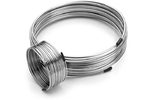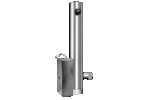- ▶
- Heaters/Source
- ▶
- Agilent Heaters and SensorsMass Spectrometry, Scientific Supplies & ManufacturingScientific Instrument Services 5973 Source Heater Tamper Resistant Allen Wrench 5973/5975 Quad Sensor 5985 Source Heater Assembly Agilent Interface Heater Assembly 5971 Interface Heater

- ▶
- Reference Material on InstrumentationArticle - A High Temperature Direct Probe for a Mass Spectrometer Design of a Direct Exposure Probe and Controller for use ona Hewlett-Packard 5989 Mass Spectrometer SIS AP1000 AutoProbe™ SIS AP2000 AutoProbe™ - Description of System HPP7: Direct Probe Electronics Console HPP7: Direct Probe for the Agilent (HP) 5973/5975 MSD HPP7: HP Direct Probe Application Notes HPP7: Installation Directions for the Direct Probe HPP7: Side Cover for the HP 5973 MSD HPP7: Support HPP7: Probe Inlet System for the Agilent (HP) 5973 and 5975 MSD with Automatic Indexed Stops HPP7: Theory of Operation of the Direct Probe and Probe Inlet System Direct Thermal Extraction Thermal Desorption Application Notes Environmental Thermal Desorption Application Notes Food Science Thermal Desorption Application Notes Forensic Thermal Desorption Application Notes GC Cryo-Trap Application Notes Headspace Application Notes Purge & Trap Thermal Desorption Application Notes Theory of Operation of the AutoDesorb® System AutoDesorb Notes for SIS Dealers Adsorbent Resin Application Notes Installation of the Short Path Thermal Desorption System on Agilent (HP) and Other GCs Installation of the Short Path Thermal Desorption System on a Varian 3400 GC AutoDesorb® System Development Team Thermal Desorption Applications and Reference Materials Installation of the Short Path Thermal Desorption System - TD5 Part I - Design & Operation of the Short Path ThermalDesorption System Installation Instructions for the Model 951 GC Cryo-Trap on the HP 5890 Series GC Installation Instructions for the Model 961 GC Cryo-Trap on the HP 5890 Series GC Operation of the Model 951/961 GC Cryo-Trap SIS GC Cryo Traps - Theory of Operation NIST/EPA/NIH Mass Spectral Enhancements - 1998 version (NIST98) SIMION 3D Ion Optics Class Mass Spectrometer Source Cleaning Methods MS Tip: Mass Spectrometer Source Cleaning Procedures Mass Spec Source Cleaning Procedures Micro-Mesh® Abrasive Sheets Research Papers Using New Era Syringe Pump Systems EI Positive Ion Spectra for Perfluorokerosene (PFK) Cap Liner Information How do I convert between fluid oz and milliliters? Which bottle material should I choose? Which bottle mouth should I choose? The Bottle Selection Guide CGA Connections for Gas Tanks Chemical Reaction Interface Mass Spectrometry (CRIMS)

- Instrument Tubing
- ▶
- Gas RegulatorsModel 3530 Series - Single Stage Purity Brass Regulator Model 3510 Series - Single Stage High Purity Stainless Steel Regulators Model 3120 Series - Dual Stage Purity Brass Regulator Model 3810 Series - Dual Stage High Purity Stainless Steel Regulators Tescom Gas Line Regulators 3420 Series Tescom Gas Line Regulators 3450 Series Concoa In-Line Regulators Model 304 Series Concoa In-Line Regulators Model 324 Series
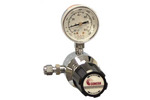
- TD
- ▶
- AccessoriesTD Supply Kit Desorption Tubes Adsorbent Resins Desorption Tube Needles Desorption Tube Seals Desorption System Fittings GC Cryo-Trap Extraction Cell TD Sample Loader Prepacked, Conditioned Desorption Tubes Desorption Tube Packing Accessories Stainless Steel Purge Heads Injection Port Liners Tenax TA Poster TD Application Notes Customer Service

- GCColumns Fused Silica Tubing Instrument Tubing Injection Port Liners Septa by Manufacturer SIS GC Cryo-Traps Ferrules Valves Swagelok® Fittings Pyrolysis Probe Accessories Gas Generators Gas Regulators Gas Purifiers and Filters Syringes SGE MEPS™-Micro Extraction by Packed Sorbent Purge and Trap System SGE SilFlow™ Stainless Steel Micro-Fluidic Platform Accessories NIST GC RI Library Other GC Supplies Catalog Page D1
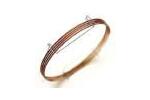
- ▶
- GC Cryo-traps
- LiteratureApplication Notes Adsorbent Resins Guide Mass Spec Tips SDS Sheets FAQ MS Calibration Compound Spectra Manuals MS Links/Labs/ Organizations MS Online Tools Flyers on Products/Services Scientific Supplies Catalog About Us NextAdvance Bullet Blender® Homogenizer Protocols Micro-Mesh® Literature Instrumentation Literature Agilent GC/MS Literature SIS News / E-Mail Newsletter NIST MS Database - Update Notifications

- ▶
- Thermal Desorption Applications and Reference MaterialsDirect Thermal Extraction Headspace Environmental Food Science Applications Pharmaceuticals Forensic Note 103: EPA Method 325B, Novel Thermal Desorption Instrument Modification to Improve Sensitivity Note 102: Identification of Contaminants in Powdered Beverages by Direct Extraction Thermal Desorption GC/MS Note 101: Identification of Contaminants in Powdered Foods by Direct Extraction Thermal Desorption GC/MS Note 100: Volatile and Semi-Volatile Profile Comparison of Whole Versus Cracked Versus Dry Homogenized Barley Grains by Direct Thermal Extraction Note 99: Volatile and Semi-Volatile Profile Comparison of Whole vs. Dry Homogenized Wheat, Rye and Barley Grains by Direct Thermal Extraction GC/MS Note 98: Flavor and Aroma Profiles of Truffle Oils by Thermal Desorption GC/MS Note 97: Flavor Profiles of Imported and Domestic Beers by Purge & Trap Thermal Desorption GC/MS Note 95: Detection of Explosives on Clothing Material by Direct and AirSampling Thermal Desorption GC/MS Note 94: Detection of Nepetalactone in the Nepeta Cataria Plant by Thermal Desorption GC/MS Note 93: Detection of Benzene in Carbonated Beverages with Purge & Trap Thermal Desorption GC/MS Note 88: Analysis of Silicone Contaminants on Electronic Components by Thermal Desorption GC-MS Note 84: Vacuum Pump Exhaust Filters - Charcoal Exhaust Traps Note 83: Vacuum Pump Exhaust Filters - Oil Mist Eliminators Note 82: Vacuum Pump Exhaust Filters Note 80: Design, Development and Testing of a Microprocessor ControlledAutomated Short Path Thermal Desorption Apparatus Note 79: Volatile Organic Compounds From Electron Beam Cured and Partially Electron Beam Cured Packaging Using Automated Short Path Thermal Desorption Note 77: The Determination of Volatile Organic Compounds in VacuumSystem Components Note 75: An Apparatus for Sampling Volatile Organics From LivePlant Material Using Short Path Thermal Desorption Note 73: The Analysis of Perfumes and their Effect on Indoor Air Pollution Note 71: Flavor Profile Determination of Rice Samples Using Shor tPath Thermal Desorption GC Methods Note 65: Determination of Ethylene by Adsorbent Trapping and Thermal Desorption - Gas Chromatography Note 64: Comparison of Various GC/MS Techniques For the Analysis of Black Pepper (Piper Nigrum) Note 63: Determination of Volatile and Semi-Volatile Organics in Printer Toners Using Thermal Desorption GC Techniques Note 60: Programmable Temperature Ramping of Samples Analyzed ViaDirect Thermal Extraction GC/MS Note 57: Aroma Profiles of Lavandula species Note 55: Seasonal Variation in Flower Volatiles Note 54: Identification of Volatile Organic Compounds in Office Products Note 43: Volatile Organic Composition In Blueberries Note 42: The Influence of Pump Oil Purity on Roughing Pumps Note 41: Hydrocarbon Production in Pine by Direct Thermal Extraction Note 40: Comparison of Septa by Direct Thermal Extraction Note 39: Comparison of Sensitivity Of Headspace GC, Purge and Trap Thermal Desorption and Direct Thermal Extraction Techniques For Volatile Organics Note 38: A New Micro Cryo-Trap For Trapping Of Volatiles At the Front Of a GC Capillary Column Note 37: Volatile Organic Emissions from Automobile Tires Note 36: Identification Of Volatile Organic Compounds In a New Automobile Note 35: Volatile Organics Composition of Cranberries Note 34: Selection Of Thermal Desorption and Cryo-Trap Parameters In the Analysis Of Teas Note 33: Changes in Volatile Organic Composition in Milk Over Time Note 32: Selection and Use of Adsorbent Resins for Purge and Trap Thermal Desorption Applications Note 31: Volatile Organic Composition in Several Cultivars of Peaches Note 30: Comparison Of Cooking Oils By Direct Thermal Extraction and Purge and Trap GC/MS Note 29: Analysis Of Volatile Organics In Oil Base Paints By Automated Headspace Sampling and GC Cryo-Focusing Note 28: Analysis Of Volatile Organics In Latex Paints By Automated Headspace Sampling and GC Cryo-Focusing Note 27: Analysis of Volatile Organics In Soils By Automated Headspace GC Note 26: Volatile Organics Present in Recycled Air Aboard a Commercial Airliner Note 25: Flavor and Aroma in Natural Bee Honey Note 24: Selection of GC Guard Columns For Use With the GC Cryo-Trap Note 23: Frangrance Qualities in Colognes Note 22: Comparison Of Volatile Compounds In Latex Paints Note 21: Detection and Identification Of Volatile and Semi-Volatile Organics In Synthetic Polymers Used In Food and Pharmaceutical Packaging Note 20: Using Direct Thermal Desorption to Assess the Potential Pool of Styrene and 4-Phenylcyclohexene In Latex-Backed Carpets Note 19: A New Programmable Cryo-Cooling/Heating Trap for the Cryo-Focusing of Volatiles and Semi-Volatiles at the Head of GC Capillary Columns Note 18: Determination of Volatile Organic Compounds In Mushrooms Note 17: Identification of Volatile Organics in Wines Over Time Note 16: Analysis of Indoor Air and Sources of Indoor Air Contamination by Thermal Desorption Note 14: Identification of Volatiles and Semi-Volatiles In Carbonated Colas Note 13: Identification and Quantification of Semi-Volatiles In Soil Using Direct Thermal Desorption Note 12: Identification of the Volatile and Semi-Volatile Organics In Chewing Gums By Direct Thermal Desorption Note 11: Flavor/Fragrance Profiles of Instant and Ground Coffees By Short Path Thermal Desorption Note 10: Quantification of Naphthalene In a Contaminated Pharmaceutical Product By Short Path Thermal Desorption Note 9: Methodologies For the Quantification Of Purge and Trap Thermal Desorption and Direct Thermal Desorption Analyses Note 8: Detection of Volatile Organic Compounds In Liquids Utilizing the Short Path Thermal Desorption System Note 7: Chemical Residue Analysis of Pharmaceuticals Using The Short Path Thermal Desorption System Note 6: Direct Thermal Analysis of Plastic Food Wraps Using the Short Path Thermal Desorption System Note 5: Direct Thermal Analysis Using the Short Path Thermal Desorption System Note 4: Direct Analysis of Spices and Coffee Note 3: Indoor Air Pollution Note 2: Detection of Arson Accelerants Using Dynamic Headspace with Tenax® Cartridges Thermal Desorption and Cryofocusing Note 1: Determination of Off-Odors and Other Volatile Organics In Food Packaging Films By Direct Thermal Analysis-GC-MS

- GC Cryo-Trap Application NotesNote 43: Volatile Organic Composition In Blueberries Note 42: The Influence of Pump Oil Purity on Roughing Pumps Note 41: Hydrocarbon Production in Pine by Direct Thermal Extraction Note 40: Comparison of Septa by Direct Thermal Extraction Note 39: Comparison of Sensitivity Of Headspace GC, Purge and Trap Thermal Desorption and Direct Thermal Extraction Techniques For Volatile Organics Note 38: A New Micro Cryo-Trap For Trapping Of Volatiles At the Front Of a GC Capillary Column Note 37: Volatile Organic Emissions from Automobile Tires Note 36: Identification Of Volatile Organic Compounds In a New Automobile Note 34: Selection Of Thermal Desorption and Cryo-Trap Parameters In the Analysis Of Teas Note 31: Volatile Organic Composition in Several Cultivars of Peaches Note 30: Comparison Of Cooking Oils By Direct Thermal Extraction and Purge and Trap GC/MS Note 29: Analysis Of Volatile Organics In Oil Base Paints By Automated Headspace Sampling and GC Cryo-Focusing Note 28: Analysis Of Volatile Organics In Latex Paints By Automated Headspace Sampling and GC Cryo-Focusing Note 27: Analysis of Volatile Organics In Soils By Automated Headspace GC Note 24: Selection of GC Guard Columns For Use With the GC Cryo-Trap Note 19: A New Programmable Cryo-Cooling/Heating Trap for the Cryo-Focusing of Volatiles and Semi-Volatiles at the Head of GC Capillary Columns

- Application NotesNote 103: EPA Method 325B, Novel Thermal Desorption Instrument Modification to Improve Sensitivity Note 102: Identification of Contaminants in Powdered Beverages by Direct Extraction Thermal Desorption GC/MS Note 101: Identification of Contaminants in Powdered Foods by Direct Extraction Thermal Desorption GC/MS Note 100: Volatile and Semi-Volatile Profile Comparison of Whole Versus Cracked Versus Dry Homogenized Barley Grains by Direct Thermal Extraction Note 99: Volatile and Semi-Volatile Profile Comparison of Whole vs. Dry Homogenized Wheat, Rye and Barley Grains by Direct Thermal Extraction GC/MS Note 98: Flavor and Aroma Profiles of Truffle Oils by Thermal Desorption GC/MS Note 97: Flavor Profiles of Imported and Domestic Beers by Purge & Trap Thermal Desorption GC/MS Note 96: Reducing Warping in Mass Spectrometer Filaments, with SISAlloy® Yttria/Rhenium Filaments Note 95: Detection of Explosives on Clothing Material by Direct and AirSampling Thermal Desorption GC/MS Note 94: Detection of Nepetalactone in the Nepeta Cataria Plant by Thermal Desorption GC/MS Note 93: Detection of Benzene in Carbonated Beverages with Purge & Trap Thermal Desorption GC/MS Note 92: Yttria Coated Mass Spectrometer Filaments Note 91: AutoProbe DEP Probe Tip Temperatures Note 90: An Automated MS Direct Probe for use in an Open Access Environment Note 89: Quantitation of Organics via a Mass Spectrometer Automated Direct Probe Note 88: Analysis of Silicone Contaminants on Electronic Components by Thermal Desorption GC-MS Note 87: Design and Development of an Automated Direct Probe for a Mass Spectrometer Note 86: Simulation of a Unique Cylindrical Quadrupole Mass Analyzer Using SIMION 7.0. Note 85: Replacing an Electron Multiplier in the Agilent (HP) 5973 MSD Note 84: Vacuum Pump Exhaust Filters - Charcoal Exhaust Traps Note 83: Vacuum Pump Exhaust Filters - Oil Mist Eliminators Note 82: Vacuum Pump Exhaust Filters Note 81: Rapid Bacterial Chemotaxonomy By DirectProbe/MSD Note 80: Design, Development and Testing of a Microprocessor ControlledAutomated Short Path Thermal Desorption Apparatus Note 79: Volatile Organic Compounds From Electron Beam Cured and Partially Electron Beam Cured Packaging Using Automated Short Path Thermal Desorption Note 78: A New Solution to Eliminate MS Down-Time With No-Tool-Changing of Analytical GC Columns Note 77: The Determination of Volatile Organic Compounds in VacuumSystem Components Note 76: Determination of the Sensitivity of a CRIMS System Note 75: An Apparatus for Sampling Volatile Organics From LivePlant Material Using Short Path Thermal Desorption Note 74: Examination of Source Design in Electrospray-TOF Using SIMION 3D Note 73: The Analysis of Perfumes and their Effect on Indoor Air Pollution Note 72: 1998 Version of the NIST/EPA/NIH Mass Spectral Library, NIST98 Note 71: Flavor Profile Determination of Rice Samples Using Shor tPath Thermal Desorption GC Methods Note 70: Application of SIMION 6.0 To a Study of the Finkelstein Ion Source: Part II Note 69: Application of SIMION 6.0 To a Study of the Finkelstein Ion Source: Part 1 Note 68: Use of a PC Plug-In UV-Vis Spectrometer To Monitor the Plasma Conditions In GC-CRIMS Note 67: Using Chemical Reaction Interface Mass Spectrometry (CRIMS) To Monitor Bacterial Transport In In Situ Bioremediation Note 66: Probe Tip Design For the Optimization of Direct Insertion Probe Performance Note 65: Determination of Ethylene by Adsorbent Trapping and Thermal Desorption - Gas Chromatography Note 64: Comparison of Various GC/MS Techniques For the Analysis of Black Pepper (Piper Nigrum) Note 63: Determination of Volatile and Semi-Volatile Organics in Printer Toners Using Thermal Desorption GC Techniques Note 62: Analysis of Polymer Samples Using a Direct Insertion Probe and EI Ionization Note 61: Analysis of Sugars Via a New DEP Probe Tip For Use With theDirect Probe On the HP5973 MSD Note 60: Programmable Temperature Ramping of Samples Analyzed ViaDirect Thermal Extraction GC/MS Note 59: Computer Modeling of a TOF Reflectron With Gridless Reflector Using SIMION 3D Note 58: Direct Probe Analysis and Identification of Multicomponent Pharmaceutical Samples via Electron Impact MS Note 57: Aroma Profiles of Lavandula species Note 56: Mass Spec Maintenance & Cleaning Utilizing Micro-Mesh® Abrasive Sheets Note 55: Seasonal Variation in Flower Volatiles Note 54: Identification of Volatile Organic Compounds in Office Products Note 53: SIMION 3D v6.0 Ion Optics Simulation Software Note 52: Computer Modeling of Ion Optics in Time-of-Flight mass Spectrometry Using SIMION 3D Note 51: Development and Characterization of a New Chemical Reaction Interface for the Detection of Nonradioisotopically Labeled Analytes Using Mass Spectrometry (CRIMS) Note 50: The Analysis of Multiple Component Drug Samples Using a Direct Probe Interfaced to the HP 5973 MSD Note 49: Analysis of Cocaine Utilizing a New Direct Insertion Probe on a Hewlett Packard 5973 MSD Note 48: Demonstration of Sensitivity Levels For the Detection of Caffeine Using a New Direct Probe and Inlet for the HP 5973 MSD Note 47: The Application Of SIMION 6.0 To Problems In Time-of-Flight Mass Spectrometry Note 46: Delayed Extraction and Laser Desorption: Time-lag Focusing and Beyond Note 45: Application of SIMION 6.0 to Filament Design for Mass Spectrometer Ionization Sources Note 44: The Design Of a New Direct Probe Inlet For a Mass Spectrometer Note 43: Volatile Organic Composition In Blueberries Note 42: The Influence of Pump Oil Purity on Roughing Pumps Note 41: Hydrocarbon Production in Pine by Direct Thermal Extraction Note 40: Comparison of Septa by Direct Thermal Extraction Note 39: Comparison of Sensitivity Of Headspace GC, Purge and Trap Thermal Desorption and Direct Thermal Extraction Techniques For Volatile Organics Note 38: A New Micro Cryo-Trap For Trapping Of Volatiles At the Front Of a GC Capillary Column Note 37: Volatile Organic Emissions from Automobile Tires Note 36: Identification Of Volatile Organic Compounds In a New Automobile Note 35: Volatile Organics Composition of Cranberries Note 34: Selection Of Thermal Desorption and Cryo-Trap Parameters In the Analysis Of Teas Note 33: Changes in Volatile Organic Composition in Milk Over Time Note 32: Selection and Use of Adsorbent Resins for Purge and Trap Thermal Desorption Applications Note 31: Volatile Organic Composition in Several Cultivars of Peaches Note 30: Comparison Of Cooking Oils By Direct Thermal Extraction and Purge and Trap GC/MS Note 29: Analysis Of Volatile Organics In Oil Base Paints By Automated Headspace Sampling and GC Cryo-Focusing Note 28: Analysis Of Volatile Organics In Latex Paints By Automated Headspace Sampling and GC Cryo-Focusing Note 27: Analysis of Volatile Organics In Soils By Automated Headspace GC Note 26: Volatile Organics Present in Recycled Air Aboard a Commercial Airliner Note 25: Flavor and Aroma in Natural Bee Honey Note 24: Selection of GC Guard Columns For Use With the GC Cryo-Trap Note 23: Frangrance Qualities in Colognes Note 22: Comparison Of Volatile Compounds In Latex Paints Note 21: Detection and Identification Of Volatile and Semi-Volatile Organics In Synthetic Polymers Used In Food and Pharmaceutical Packaging Note 20: Using Direct Thermal Desorption to Assess the Potential Pool of Styrene and 4-Phenylcyclohexene In Latex-Backed Carpets Note 19: A New Programmable Cryo-Cooling/Heating Trap for the Cryo-Focusing of Volatiles and Semi-Volatiles at the Head of GC Capillary Columns Note 18: Determination of Volatile Organic Compounds In Mushrooms Note 17: Identification of Volatile Organics in Wines Over Time Note 16: Analysis of Indoor Air and Sources of Indoor Air Contamination by Thermal Desorption Note 14: Identification of Volatiles and Semi-Volatiles In Carbonated Colas Note 13: Identification and Quantification of Semi-Volatiles In Soil Using Direct Thermal Desorption Note 12: Identification of the Volatile and Semi-Volatile Organics In Chewing Gums By Direct Thermal Desorption Note 11: Flavor/Fragrance Profiles of Instant and Ground Coffees By Short Path Thermal Desorption Note 10: Quantification of Naphthalene In a Contaminated Pharmaceutical Product By Short Path Thermal Desorption Note 9: Methodologies For the Quantification Of Purge and Trap Thermal Desorption and Direct Thermal Desorption Analyses Note 8: Detection of Volatile Organic Compounds In Liquids Utilizing the Short Path Thermal Desorption System Note 7: Chemical Residue Analysis of Pharmaceuticals Using The Short Path Thermal Desorption System Note 6: Direct Thermal Analysis of Plastic Food Wraps Using the Short Path Thermal Desorption System Note 5: Direct Thermal Analysis Using the Short Path Thermal Desorption System Note 4: Direct Analysis of Spices and Coffee Note 3: Indoor Air Pollution Note 2: Detection of Arson Accelerants Using Dynamic Headspace with Tenax® Cartridges Thermal Desorption and Cryofocusing Note 1: Determination of Off-Odors and Other Volatile Organics In Food Packaging Films By Direct Thermal Analysis-GC-MS Tech No. "A" Note 14: Elimination of "Memory" Peaks in Thermal Desorption Improving Sensitivity in the H.P. 5971 MSD and Other Mass Spectrometers - Part I of II Improving Sensitivity in the H.P. 5971 MSD and Other Mass Spectrometers- Part II of II Adsorbent Resins Guide Development and Field Tests of an Automated Pyrolysis Insert for Gas Chromatography. Hydrocarbon Production in Pine by Direct Thermal Extraction A New Micro Cryo-Trap for the Trapping of Volatiles at the Front of a GC Capillary (019P) - Comparison of Septa by Direct Thermal Extraction Volatile Organic Composition in Blueberry Identification of Volatile Organic Compounds in Office Products Detection and Indentification of Volatiles in Oil Base Paintsby Headspace GC with On Column Cryo-Trapping Evaluation of Septa Using a Direct Thermal Extraction Technique INFLUENCE OF STORAGE ON BLUEBERRY VOLATILES Selection of Thermal Desorption and Cryo-Trap Parameters in the Analysis of Teas Redesign and Performance of a Diffusion Based Solvent Removal Interface for LC/MS The Design of a New Direct Probe Inlet for a Mass Spectrometer Analytes Using Mass Spectrometry (CRIMS) Application of SIMION 6.0 to Filament Design for Mass Spectrometer Ionization Sources A Student Guide for SIMION Modeling Software Application of SIMION 6.0 to Problems in Time-of-flight Mass Spectrometry Comparison of Sensitivity of Headspace GC, Purge and TrapThermal Desorption and Direct Thermal Extraction Techniques forVolatile Organics The Influence of Pump Oil Purity on Roughing Pumps Analysis of Motor Oils Using Thermal Desorption-Gas Chromatography-Mass Spectrometry IDENTIFICATION OF VOLATILE ORGANIC COMPOUNDS IN PAPER PRODUCTS Computer Modeling of Ion Optics in Time-of-Flight mass Spectrometry using SIMION 3D Seasonal Variation in Flower Volatiles Development of and Automated Microprocessor Controlled Gas chromatograph Fraction Collector / Olfactometer Delayed Extraction and Laser Desorption: Time-lag Focusing and Beyond A New Micro Cryo-Trap for the Trapping of Volatiles at the Front of a GC Column Design of a Microprocessor Controlled Short Path Thermal Desorption Autosampler Computer Modeling of Ion Optics in Time-of-Flight Mass Spectrometry Using SIMION 3D Thermal Desorption Instrumentation for Characterization of Odors and Flavors

- ▶
- Note 19: A New Programmable Cryo-Cooling/Heating Trap for the Cryo-Focusing of Volatiles and Semi-Volatiles at the Head of GC Capillary Columns (This Page)
By John J. Manura , Chris Baker and John Manos
1999
INTRODUCTION
The Cryo-Trap consists of a small heating and cooling chamber which surrounds the front 5 inches of the GC capillary column. This unit is installed inside the GC column oven just under the GC injection port to permit the trapping of volatiles and semi-volatiles either on column or on a guard column in front of the capillary column. A separate digital dual temperature range controller permits the accurate temperature setting and regulation of both the heating and cooling temperatures of the GC Cryo-Trap. The system can be used either manually to switch between the cooling and heating cycles or can be operated automatically via an input signal from a controlling device, as the S.I.S. Short Path Thermal Desorption System or GC signal switch. This new GC Cryo-Trap was originally designed for use in conjunction with the S.I.S. Short Path Thermal Desorption System, but has additional applications, as the GC headspace analysis. This will be demonstrated. Normally, in order to cryo trap volatiles at the head of the GC column, the entire GC oven is cryo cooled using liquid C02 at temperatures that cannot go below -40 degrees C. With the new GC Cryo-Trap, volatiles can be trapped at temperatures down to -70 degrees C at the head of the GC column using less than CO2 of the C02 required to cool the entire GC oven. This results in more efficient trapping of the volatiles on column as well as substantial cost savings in C02. To release the volatiles from the Cryo-Trap, a heater coil inside the Cryo-Trap rapidly heats the capillary column to temperatures up to 400 degrees C. The released organics are subsequently temperature programmed through the GC column.
Theory of Operation
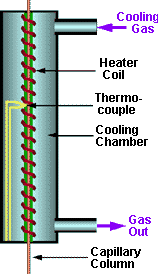
The GC Cryo-Trap consists of a small heating/cooling chamber which is 3/4" in diameter and 5" long (Figure # 1). The GC capillary freely passes through the center of this chamber via a 1/16" O.D. stainless steel capillary guide tube. Capillary columns or guard columns up to megabore sizes (0.53 mm I.D.) can pass through this stainless steel capillary guide tube. Around the stainless steel capillary guide tube, a heating coil is wound to provide for the rapid heating of the capillary guide tube and GC capillary guard column. A thermocouple is attached to the stainless steel capillary guide tube to provide the signal to regulate the heating and cooling temperatures and to display the temperature on the digital temperature display of the Electronics Control . Liquid C02 for the cooling of the Cryo-Trap is introduced into the top inlet via an electrically controlled valve. The bottom outlet vents the dispersed C02 into the GC oven, or optionally it can be vented external to the GC via appropriate plumbing.
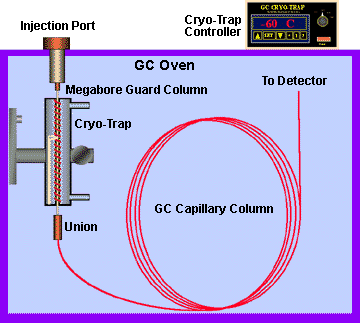
Figure # 2 - GC Cryo-Trap in GC Oven
The Cryo-Trap mounts on the side of the oven wall using a specially designed mounting bracket in the H.P. 5890 series gas chromatographs (Figure # 2). On the Varian and other model gas chromatographs, the Cryo-Trap mounts to the injection port column fitting with the clamp provided. No drilling or other GC modifications are required for the installation of the GC Cryo-Trap in any GC oven. Power requirements are 110 VAC, 3 amp max. An external supply of Liquid C02 is required for the cooling operation.
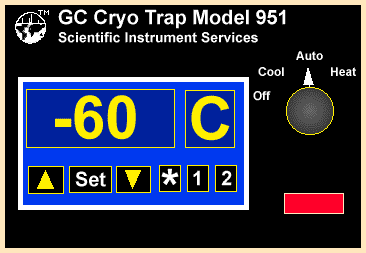
Figure # 2b - GC Cryo-Trap Electronics Control Module
Both heating and cooling of the Cryo-Trap are controlled by the Cryo-Trap Electronics Control provided with the system. The heating and cooling temperatures are set via the digital temperature controller (Figure # 2b). The Electronics Control can be used to manually switch between cooling and heating or optionally can be controlled automatically via an input signal provided by the GC operating system or by a controlling system, as the Short Path Thermal Desorption System. This input switches the system from the normal cooling cycle to the heating cycle when the chromatography is ready to begin. Cryo-Cooling temperatures down to -70 deg C can be set via the controller using liquid C02 as the cooling gas. Liquid Nitrogen can not be used with this system. A new model is now available for cooling with liquid nitrogen at temperatures down to 180 deg. C (Model 961). Heating temperatures, to remove the trapped volatiles from the trap, of up to 400 degrees C are achievable at a ramp rate greater than 800 degrees C per minute. This provides more than sufficient heating to release both the volatiles and semi-volatiles from the trap efficiently with sharp and narrow peak shapes.
The GC Cryo-Trap was originally designed to be used with the S.I.S. Short Path Thermal Desorption System. New software for the Desorption System permits the remote 2 connector on the back of the Short Path Thermal Desorption System Model TD-2 to be used for the automatic control of the Cryo-Trap. This will automatically switch the Cryo-Trap to begin the cooling cycle, when the initial gas purge step is begun on the Thermal Desorption system. When the Desorption process is complete, the Thermal Desorption system will activate the Cryo-Trap to switch from the cooling cycle to the heating cycle and begin the GC oven temperature program. Optionally, an input signal from a GC system program or other relay switching signal that can provide for a switch closure at the appropriate sequence of events in the analysis of your samples can be utilized to control the operation of the GC Cryo-Trap.
The new S.I.S. Short Path Thermal Desorption System incorporates the electronics in the desorption system controller. Therefore, a separate controller is not required when using the TD-3 thermal desorption system. All other desorption systems and headspace injectors will require the electronics temperature controller described above.
Selection of Cryo-Trap Cooling Temperature
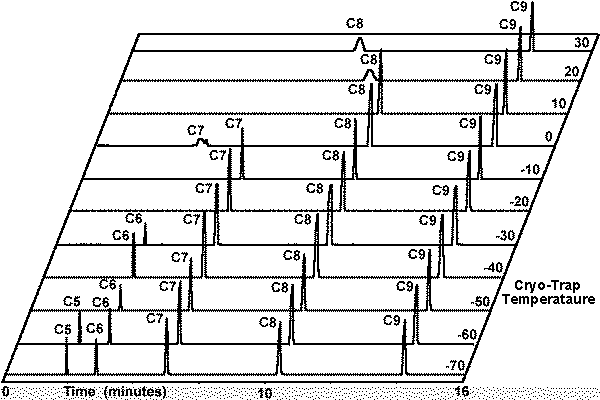
Figure # 3 - Trapping Efficiency of Hydrocarbons On the GC Cryo-Trap As a Function of Temperature
The cooling temperature of the Cryo-Trap can be set at any value from GC oven temperature down to -70 deg C for the Model 951 GC Cryo-Trap or down to 180 deg for the model 961 GC Cryo-Trap. This temperature depends on the requirements of the user and the range of compounds that need to be cryo-trapped and subsequently chromatographed. Figure # 3 shows the efficiency of the GC Cryo-Trap for the trapping of a series of the straight chain hydrocarbons pentane (C-5) through nonane (C-9). For this analysis, a guard column was used inside the Cryo-Trap which consisted of a DB-5 megabore column, 0.53 mm I.D. x 150 mm long x 5.0 u film thickness. The GC column consisted of a 0.32 mm I.D. x 60 meter x 0.25 u film thickness DB-5-MS (J&W) capillary column. At room temperature (20 deg. C), only nonane (C9) is effectively trapped on the guard column. The lower molecular weight hydrocarbons pass through the guard column without being retained. As the temperature of the Cryo-Trap is sequentially lowered, additional lower boiling hydrocarbons are trapped on the guard column inside the Cryo-Trap. At the lowest temperature (-70 deg. C), pentane (C-5) is effectively trapped on the Cryo-Trap guard column and subsequently chromatographed. The resulting GC peak has excellent resolution and symmetrical peak shape. By operating the Cryo-Trap at -70 deg C, compounds such as pentane with melting points of -100 deg C can be effectively trapped on the guard column. Using this thick film megabore guard column at -70 deg C we have been able to accurately quantify acetone, ethyl acetate, methylene chloride and chloroform in pharmaceuticals using the Cryo-Trap in conjunction with the S.I.S. Short Path Thermal Desorption system. The resolution of the eluted peaks is very sharp. In particular the early eluting peaks are sharper than could be achieved via direct injection of these compounds.
Selection of Guard Columns
The selection of the Guard column that passes through the Cryo-Trap depends on the requirements of the user. The purpose of the guard column is to trap the volatiles and semi-volatiles on the inner surface of this column inside the Cryo-Trap using liquid C02 as the cooling fluid, and then to rapidly release these organics when the guard column is heated. Normally the guard column should not extend more than 20 mm beyond the end of the Cryo-Trap. This is particularly important when thick film guard columns are used, otherwise peak broadening will occur. A low dead volume connectors used to join the guard column to the GC capillary column (Figure # 2).
For higher boilers such as the semi-volatiles, a blank deactivated guard column provides for the optimum resolution of analysis. This will provide for trapping based on the melting points of the compounds of interest. Compounds that are trapped on the uncoated fused silica guard columns are rapidly released when the guard column is heated causing the eluted compounds to adsorb on the front of the capillary column in a very narrow band. This results in the highest resolution of chromatographic peaks. The use of megabore (0.53 mm I.D.) columns will minimize the occurrence of water plugs and permit the analysis of larger sample sizes. However, the uncoated guard columns will not trap compounds with melting points below the cryotrapping temperature which may limit their usefulness for many of the volatile organics.
For most volatiles, the capillary column itself can be used in place of the guard column by passing the capillary column straight through the Cryo-Trap and into the GC injection port. This type of connection has the advantage that no additional fittings such as capillary GC unions are required (therefore less chance for leaks to develop). However, use of thin film capillary columns may not adequately trap some of the very volatile organics. If microbore capillary columns are utilized for analysis, there are advantages to using megabore guard columns due to their ability to handle larger sample sizes and minimize the formation of water plugs.
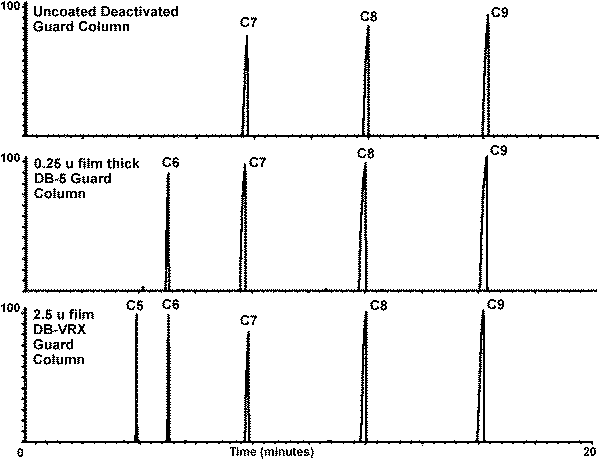
Figure # 4 - Effect of Guard Columns On the Analysis of Hydrocarbons Using the GC Cryo-Trap
In order to trap the more volatile organics, guard columns with thicker liquid phases perform the best. Figure # 4 demonstrates this improvement in performance with increasing thickness of liquid phase coatings. When the same series of straight chain hydrocarbons are analyzed as in the cryo cooling study above, the uncoated deactivated fused silica guard column traps hydrocarbons down to heptane (C-7). By trapping on a 0.25 u film thickness DB-5 column, hydrocarbons down to hexane (C6) can be trapped using the Cryo-Trap. When the thick film guard column (2.5 u film thickness DB-VRX) is used in the Cryo-Trap, pentane (C-5) is effectively trapped on the guard column. The same results were obtained with a 5.0 u film thickness DB-5 megabore guard column. While providing for the efficient trapping of volatile organics, this thick film guard column may not be useful if higher molecular weight compounds are to be analyzed. These higher molecular weight compounds may prove difficult to remove from the thick film guard columns at the upper temperature limits of the liquid phase. As a result, peak shape of the higher boilers will suffer if thick film guard columns are utilized. For the analysis of semi-volatiles (such as the PNA'S), uncoated deactivated fused silica guard columns are normally used. For even more volatile organics, as gases, micropacked megabore columns could also be used as guard columns. However, these columns have limitations in the range of compounds that can be desorbed off the packing as well as the upper temperature limit of the packing.
Guard columns from microbore through megabore are usable inside the GC Cryo-Trap. Megabore guard columns are normally recommended due to their larger surface area which permits the trapping of larger sample sizes with higher water content. A slight loss in resolution may be evident when megabore guard columns are used in the GC Cryo-Trap. In contrast, the microbore guard columns will provide for slightly higher resolution but are more susceptible to the formation of ice plugs if the samples analyzed contain any appreciable levels of water.
Thermal Desorption Applications
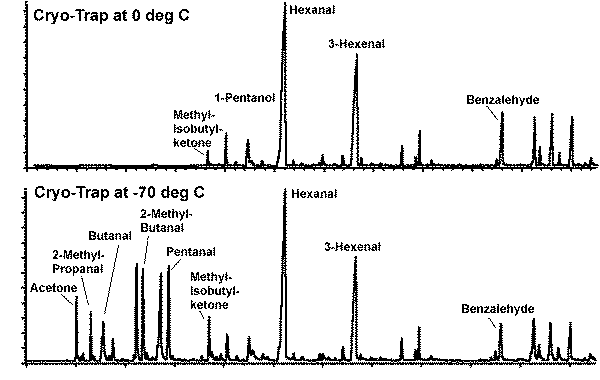
Figure 5 - Comparison of Cryo-Trap Temperatures. Purge & Trap of 200 mg Black Tea at 80 deg. C, 450 ml Purge Onto Tenax® TA, Desorb at 250 Degrees C Into GC
Figure # 5 5 demonstrates the usefulness of the Cryo-Trap to trap the volatiles from a sample of Black Tea. The sample was prepared by purging the volatiles from 200 milligrams of black tea in 5.0 ml of water at 80 deg. C. The volatiles were trapped on a Tenax TA trap and then thermally desorbed into the GC injection port at a desorption temperature of 250 deg. C for 5.0 minutes. A 5.0 u film thickness megabore DB-5 column was used as the guard column and a 60 meter by 0.32 mm I.D. by 0.25 u film thickness DB-5-MS capillary column was used for the chromatographic analysis. The GC was programmed from 30 deg to 250 deg. at 3 deg./minute. In the top chart, the Cryo-Trap was set to 0 degrees C to trap the volatiles. Volatiles down to Methyl-Isobutyl ketone were trapped. When the Cryo-Trap was set to -70 degrees C, more than eight additional volatiles including acetone were trapped and identified which were not trapped at the higher Cryo-Trap temperature. In many instances, the detection and identification of these lighter volatiles are important. These lighter volatiles can be easily analyzed utilizing the GC Cryo-Trap. Analysis by other methods, as liquid extraction, would produce poor sensitivity of these compounds due to sample loss via evaporation during sample extraction and concentration. The thermal desorption process in conjunction with the GC Cryo-Trap proves useful for the isolation and chromatography of these volatile compounds.
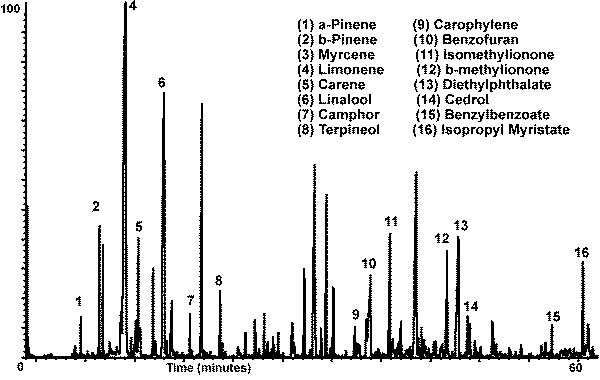
Figure # 6 - Purge & Trap of 0.3 ul of Men's Cologne, Purge Onto Tenax TA, Desorb at 250 Degrees Into GC
An example of a Purge and Trap Thermal Desorption analysis of Men's Cologne is demonstrated in Figure # 6. For this sample 0.3 ul of the cologne was injected onto a Tenax TA desorption trap via the S.I.S. Direct Injection Adaptor. The Tenax Trap was then purged off line with 200 ml of Helium at room temperature (25 degrees C) to remove the water and ethanol from the sample. Since water and ethanol comprise the majority of this sample, it is advantageous to purge or remove these materials from the sample. This will result in better chromatography and resolution of the resultant peaks in the chromatogram. The Tenax Trap was then transferred to the Thermal Desorption system and thermally desorbed at 260 degrees for 5.0 minutes into the GC injection port. The GC Cryo-Trap was maintained at -20 degrees C during the desorption process after which it was heated to 200 degrees C. An uncoated deactivated megabore fused silica guard column was used in the Cryo-Trap and the chromatography was accomplished on a 60 meter by 0.32 mm I.D. by 0.25 u film thickness DB-5-MS capillary column. The GC column was programmed from 60 deg to 280 deg at 3 deg./min. A large number of terpenoid type compounds indicative of plant or flower extracts were detected and identified in this sample. In addition, several alcohols, aliphatic hydrocarbons, aromatics and phthalates were also identified among the more than 200 peaks in the chromatogram. This sample demonstrates the usefulness and versatility of the combination of thermal desorption and the GC Cryo-Trap for the analysis of liquid samples.
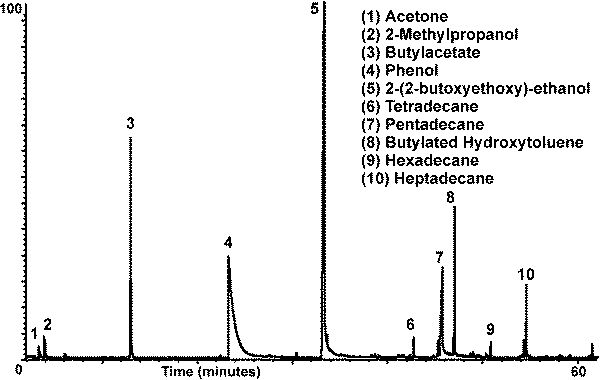
Figure # 7 - Direct Thermal Extraction of Penicillin at 150'C
We have previously utilized the Short Path Thermal Desorption System for the analysis of residual solvents in pharmaceutical and other solid materials. The use of the GC Cryo-Trap has extended the range of compounds that can be detected and identified using this accessory. Previously, we utilized liquid C02 to cool the entire GC oven. This technique was limited to cooling the oven to -40 deg. C. Attempts to cool the oven colder used excessive amounts of C02. However, the GC Cryo-Trap can routinely trap volatiles at -70 deg. C utilizing only 10% of the liquid C02 used to cool the entire GC oven. An example of the detection and analysis of residual solvents in the solid pharmaceutical Penicillin, is exhibited in Figure # 7. For this analysis, 64 milligrams of the crushed penicillin was inserted in the desorption tube on top of a glass wool plug. The sample was placed in the Thermal Desorption system and thermally extracted at 150 deg. C into the GC injection port. The GC Cryo-Trap was maintained at -70 deg C during the desorption process after which it was heated to 200 deg C. The guard column was a 5.0 u film thickness DB5 megabore column. The analysis was performed on a 60 meter by 0.32 mm I.D. by 0.25 u film thickness DB-5-MS capillary column programmed from 30 deg. to 250 deg. at 3 deg./min. In addition to the compounds previously observed when the entire oven was cooled, we were now able to detect and identify trace levels of acetone and 2-methylpropanol. This was attributable to the lower trapping temperatures achieved by the GC Cryo-Trap.
In many cases, it is advantageous to operate the Cryo-Trap at higher temperatures. This is useful when samples for analysis contain high quantities of water. It is also useful in order not to trap the dilution or sample solvent on the guard column. By maintaining the guard column and the capillary analysis column above the melting points of the solvent, these organics will pass through the columns without being retained during the desorption process, while the higher molecular weight compounds will be trapped on the guard column for subsequent analysis. The GC Cryo-Trap can maintain the guard column temperature at any temperature from the column temperature itself down to -70 degrees C.
Headspace GC Analysis
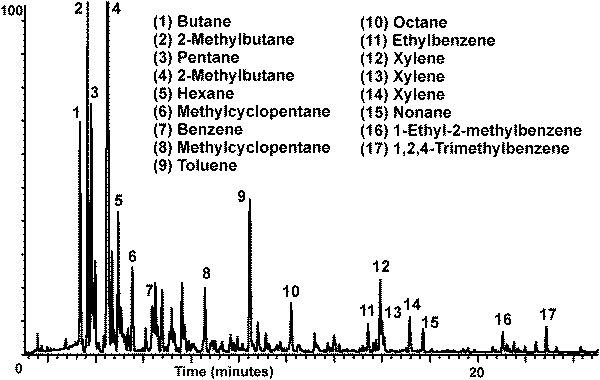
Figure # 8 - GC Headspace Analysis of Gasoline Vapor via GC Cryo-Trap. Gasoline Vapor In Air at 0.01 ul/ml. Inject 1.0 ml of Headspace Air Into GC Capillary Column Over 15 sec. Cryo-Trap At -70 deg. C For 2. 0 min Then Heat Cryo Trap to 200 deg. C and Then Chromatograph.
The GC Cryo-Trap can also be used with GC headspace techniques. In many GC headspace methods, as Forensic Arson testing, 1.0 ml of air is injected directly onto a 2 mm to 4 mm I.D. packed column. The large diameter packed GC columns are capable of handling this large volume sample size, since the normal column flow is 15 to 60 ml/min. However, with GC microbore capillary columns which operate at flow rates from 0.5 to 2.0 ml/min, the injection of 1.0 ml of air sample would result in very broad tailing chromatographic peaks due to the large sample volume in relation to the capillary column flow. By using the GC Cryo-Trap set to -70 deg. C and injecting 1.0 ml of air into the GC injection port, the volatiles are trapped on the guard column inside of the Cryo-Trap. No matter how large the sample or the time of injection, the organic compounds are trapped effectively in the guard column. Figure #8 demonstrates the analysis of a reference arson sample. The sample was prepared by injecting 1.0 ul of gasoline into a 100 ml clean glass flask with PTFE sealed cap. The flask was heated to 60 C for 5.0 minutes. This provides for a concentration of gasoline of 0.01 ul/ml in air. One (1.0) milliliter of air from the flask was injected into the GC injection port slowly over about a 15 second time interval using a 3 cc plastic disposable syringe. The GC was operated in the splitless mode and the sample was cryo trapped in the Cryo-Trap at -70 deg. C for 2.0 minutes. This allowed sufficient time to trap the organics from this large sample volume in the Cryo-Trap. A 5.0 u film thickness DB-5 megabore guard column was used in the Cryo-Trap and a 60 meter by 0.32 mm I.D. by 0.25 u film thickness DB-5-MS capillary column was used for the analysis. After the injection and cryo-trapping step was complete, the Cryo-Trap was heated to 200 deg. C and the GC programmed from 30 deg. to 100 deg. C at 300 deg./min. The resulting chromatogram exhibits a wide range of volatile hydrocarbons and aromatics. Several light volatiles including butane and pentane produced highly resolved and symmetrical GC peaks. This technique could be applied to other headspace techniques to permit the use of microbore columns and extend the usefulness of this technique.
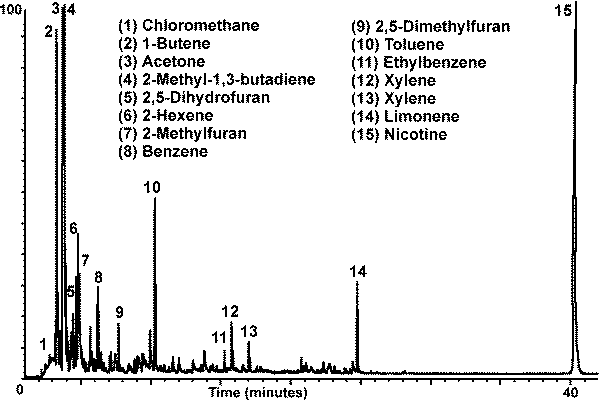
Figure # 9 - 2.0 ml of Air Containing Tobacco Smoke (15 minutes after burning) Injected Into GC and Trapped on Cryo-Trap at -70 deg C for 2.0 Minutes. GC Temperature Program from 30 to 250 deg. C at 3 deg/min. Direct Thermal Extraction of Penicillin At 150'C
A second sample of the headspace analysis utilizing the GC Cryo-Trap is shown in Figure # 9. For this analysis, smoke from a burning cigarette was permitted to collect in a 100 ml flask which was then sealed. The sample was allowed to set for 15 minutes to permit the particulate matter to settle out of the gas phase, after which 2.0 ml of the air sample were removed from the flask using a 3.0 ml plastic disposable syringe. This gas sample was then injected into the GC injection port over about 10 seconds and trapped on the GC Cryo-Trap at -70 deg. C. The guard column and capillary column and conditions are identical to the gasoline in air sample analyzed above. The major peak in the chromatogram was nicotine. From the analysis of several samples of tobacco smoke, it was determined that the ratio of nicotine to the other volatiles present in the cigarette decreased with time. In addition to nicotine, a large number of aromatics and other organics were identified in the cigarette smoke.
Conclusion
The GC Cryo-Trap has proven to be a useful technique for the analysis of volatiles and semi-volatiles via Thermal Desorption and Headspace GC techniques. These volatile organics are trapped in a narrow band in a capillary guard column in the GC Cryo-Trap at the head of the GC column for subsequent GC analysis. This reduces the use of C02 by more than 90% as compared to cooling the entire GC oven. In addition, cooling temperatures down to -70 degrees C are routinely utilized with the GC Cryo-Trap. The GC Cryo-Trap interfaces with the S.I.S. Short Path Thermal Desorption System and other relay switch controllers for the automatic control and operation of the Cryo-Trap. The GC Cryo-Trap permits the trapping and analysis of volatile organics via several GC introduction techniques and analysis methods to permit the analysis of compounds that would have been otherwise difficult to analyze.


